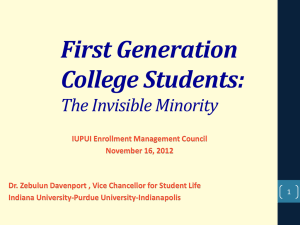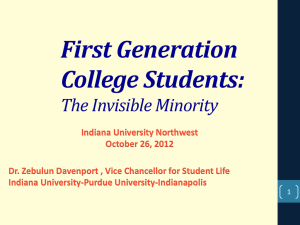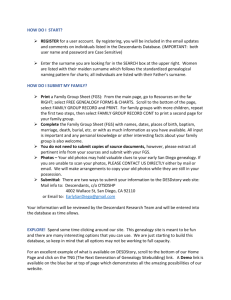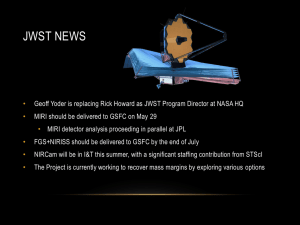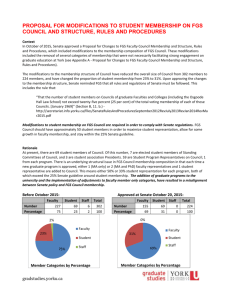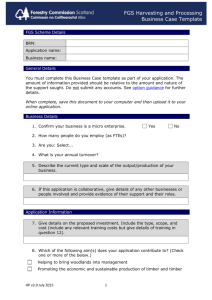JWST FGS SRR April 7, 2004 Ed Nelan TIPS
advertisement
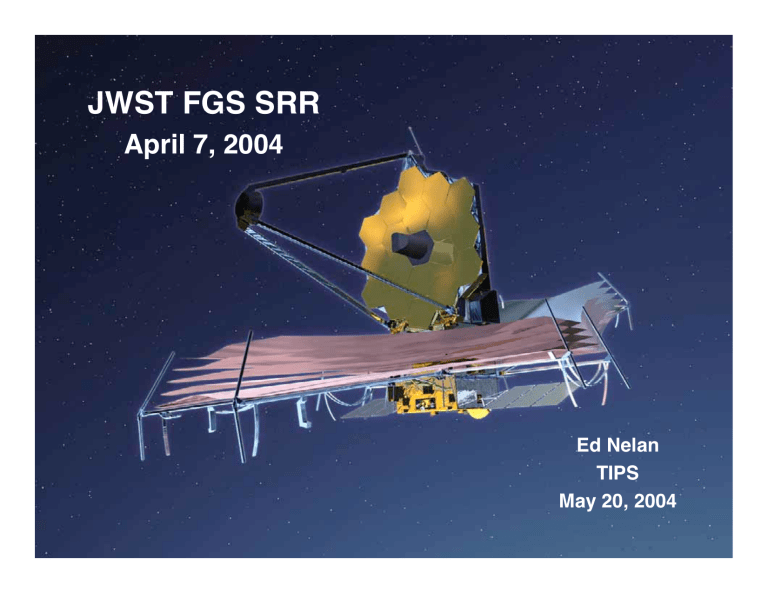
JWST FGS SRR April 7, 2004 Ed Nelan TIPS May 20, 2004 FGS SRR 7-April-04 02-1 System Requirements Review: Objectives The FGS SRR will be a joint CSA/NASA review. • The System Requirements Review (SRR) assesses the completeness of the baseline System and Instrument requirements for the FGS and identifies any potential performance non-compliance’s or marginal design aspects. • A successful SRR demonstrates that the Instrument conceptual design is ready to proceed into preliminary design. • Flow-down of requirements will be emphasized. FGS SRR 7-April-04 02-2 System Requirements Review: Process • • Requirements Overview: • • • • JWST System & Requirements Flow FGS Requirements Flow Trace of all FGS Requirements from ISIM Requirements Classification of FGS Requirements • • • FGS-Guider FGS-TF FGS Assemblies: • Optical Assembly (Structure, Optics, Detectors, Mechanisms) • FPE/ICE Assemblies (FPE, ICE, TCE) • C&DH Assembly (SBC, Memory, Interfaces, Software) SRR Process • For each class of requirements those which are design drivers are identified and will be presented in more detail. FGS SRR 7-April-04 02-3 JWST Observatory Architecture Optical Telescope Element (OTE) Primary Mirror (PM) • 18 (1.315 m) hex segments • Semi-rigid WFS&C for phasing • Deployable chord fold ISIM • NIRCam, NIRSpec, MIRI & FGS Secondary Mirror (SM) Sunshield • Passive cooling of ISIM/OTE to <40K Spacecraft Bus FGS SRR 7-April-04 Tower 02-4 FGS Requirements Flow & Status System JWST Mission Requirements JWST-RQMT-000634 MRD JWST Science Requirements Document JWST-RQMT-002558 JWST Observatory Specification OBS JWST-SPEC-002020 OBS Baselined In CM Review Drafts Available Allocation Documents Phase B Documents JWST Mission Operations Concept Document JWST-OPS-002018 Segment Element ISIM Requirements Document JWST-RQMT-000835 ISIM ISIM to OTE and Spacecraft IRD JWST-IRD-000640 ISIM to OTE and IOS-IR JWST-ICD-001831 All FGS rqmts flow from ISIM FGS Science Rational & Analysis Document Subsystem Mission Assurance Requirements For the JWST Instruments JWST-RQMT-002363 MAR IOSC FGS IRD JWST-IRD-000783 IF FGS to ISIM ICD JWST-ICD-000727 CSA Performance Assurance Requirements IFC FGS Instrument Performance and Functional Requirements JWST-SPEC-002069 FGS FGS Guider Operations Concept FGS Tunable Filter Operations Concept FGS Optical Assembly Requirements FGS SRR 7-April-04 CSA FGS Specification FGS FPE/ICE/TCE Requirements FGS C&DH Requirements FGS Flight Software Requirements 02-5 FGS Future Requirements Flow Phase A Documents CSA Performance Assurance Requirements FGS Tunable Filter Operations Concept FGS Instrument Performance and Functional Requirements JWST-SPEC-002069 FGS FGS Interface Requirements JWST-IRD-000783 IF FGS Science Rationale & Analysis Document FGS Guider Operations Concept Phase B Documents LY N O PT E C CON FGS Optical Assembly Requirements FGS Specification IFC FGS FPE/ICE/TCE Requirements TMA (Optics) Specification OA Structure Requirements Filter Wheel & Drive Specification Blocking Filter Requirements FPE Requirements Focus Mechanism & Drive Specification Tunable Filter Requirements ICE Requirements Detector Specification Coronagraphic Mask Requirements FGS SRR 7-April-04 FGS Interface Control Document JWST-ICD-000727 C&DH Specification Flight Software Requirements FPE/ICE/TCE Power Supply Specification Baselined In CM Review Drafts Available Allocation Documents Phase B Documents 02-6 FGS Requirements Flow (1 of 6) FGS SRR 7-April-04 02-7 FGS Requirements Flow •One ISIM requirement can spawn several FGS requirements, but each FGS requirement must have just one ISIM “parent”. •An ISIM requirement can be flowed to FGS from higher level (i.e., 95% guide star availability is a mission level requirement that must be met by the FGS.) FGS SRR 7-April-04 02-8 New ISIM Requirements Number Status Requirement Comment ISIM-xxx TBD FGS Optical Distortion ISIM-xxx TBD FGS-TF Optical Distortion (Astrometric Calibration) Initial flowdown of OBS-93 (SI+OTE field distortion correction) was removed, although this is partly a ground allocation, there should be a requirement for the SI ‘s and FGS-Guider to collect data to support the ground calibration. Note that in the case of the FGS-Guider there is a related requirement ISIM-589 Pointing Accuracy but its purpose is different. ISIM-xxx TBD FGS-Guider Acquisition Performance during Large (<20”) Slews ISIM-xxx TBR FGS-Guider Acquisition Performance during Small (<1”) Slews ISIM-xxx Moving Target The Observatory will slew to a target during Acquisition or Fine Guiding, and a performance should be specified during the slew. Also there is the potential Observatory The slew parameters will be described in the FGS IRD Section 3.8. A moving target requirement has been discussed and is assumed to imply 30 mas / s rates where the FGS-Guider NEA can relax to >4.3 mas Key Requirements change requests in process for Mission / Observatory Requirements FGS SRR 7-April-04 Requirements change requests in process for ISIM Requirements 02-9 FGS (IPFR) TBD/TBR Requirements Number Status Requirement Comment FGS-104 TBD Operating Modes, Updates Define which parameters can be updated “on the fly” (while guiding), and which should be restricted to updating on subsequent command: For ISIM Requirements FGS-117 TBD Identification Image Collection IRD needs to specify maximum allowable motion rate (low slew rate mode) for entry into Identification Mode. Estimated to be ~1”/50 s. FGS-124 TBD Acquisition Mode Entry IRD needs to specify maximum allowable motion rate (low slew rate mode) for entry into Acquisition Mode. Estimated to be 0.5”/s. FGS-231 TBR Identification Mode, Sensitivity Derive dimmest identifiable star (min Jab). FGS–239 TBR Identification Mode, Pattern Recognition Derive max. # of objects to be processed by recognition algorithm. FGS–242 TBD Identification Mode, Single Stars Specify min. angular separation of binary star systems that need to be resolvable. FGS–262 TBD Acquisition Mode, Single Stars Specify min. angular separation of binary star systems that need to be resolvable. FGS–268 TBR Image Motion Rate, Large Angle Slews Specify max. motion rate for Acquisition Mode. (See “New ISIM Reqs.”) FGS–270 TBR Image Motion Rate, Small Angle Slews Specify max. motion rate for Acquisition Mode. (See “New ISIM Reqs.”) FGS-277 TBR NEA Magnitude Limit ISIM Spec TBR dim magnitude limit. FGS–393 TBD TF Wavefront Error, Long Term Stability ISIM / IRD needs to specify allowable I/F temp. rate of change. FGS–403 TBD TF PSF Anisotropy ISIM Spec TBR low order asymmetric wave front error. FGS–405 TBD TF PSF Anisotropy Stability Specify low order asymmetric wave front error variation. FGS–436 TBR Power-Up Duration ISIM Spec TBR power-up duration. FGS–567 TBD Guider Temporal Efficiency ISIM Spec TBD Guider efficiency. FGS–569 TBR TF Temporal Efficiency ISIM Spec TBR TF efficiency. Requirements change requests in process for ISIM Requirements FGS SRR 7-April-04 Requirements change requests in process for IRD Requirements FGS to determine requirements via analysis (operations input) 02-10 FGS-Guider Operations Concept Requirements Driving the Design and Operation of the FGS-Guider • ISIM-264 (MR-171) Guide Star Availability • 95% guide star availability (with both FGS channels) • ISIM-265 (MR-365) FGS Single-Point Failure • 90% guide star availability (single channel) • ISIM-591 (OBS-1677) FGS Noise Equivalent Angle • 3.5 mas/axis RMS determines sensitivity & total FOV for guide function, limiting magnitude of candidate guide stars, catalog performance FGS SRR 7-April-04 02-11 Current JWST FOV Layout Coronagraphic Spot Location 20” 80” 1 FGS SRR 7-April-04 2 02-12 JWST FOV Layout Coronagraphic Spot Location 20” 80” 1 FGS SRR 7-April-04 2 02-13 JWST FOV Layout Coronagraphic Spot Location 20” 80” ? FGS SRR 7-April-04 1 2 02-14 Loss of a Single Channel (FOV) in FGS • ISIM-265 requires 90% probability of a guide star being available following the loss of 1 FGS FOV. • • • • trade off between instrument sensitivity & remaining FOV that can be used to access guide stars (is FGS-TF available for guiding?). CSA has proposed sensitivity to access guide stars with JAB<19. Nelan & Kriss (STScI-JWST-TM-2004-0008) show that using GSC-2, ISIM-265 is not achieved for JAB<19 unless FGS-TF can be used as a guider.* We registered our concern that FGS-TF is not required to be capable of guide function. We also tried unsuccessfully to add a requirement that GSC-2 be the JWST GSC. *On going study of GSC-2 suggests with JAB<19.5 FGS will meet ISIM-265 w/o FGS-TF FGS SRR 7-April-04 02-15 Guide Star Identification Issues • During SRR there was an extended discussion about the guide star identification process as this drive cost for FSW and the FGS C&DH. • FGS-Guider OCD points out that FGS will be confronted with both sparse and crowded fields. Same guide star identification should be applied in both cases. FGS SRR 7-April-04 02-16 Guide Star Recognition FGS images the sky, FGS SRR 7-April-04 02-17 Guide Star Recognition overlays a “catalog segment”, FGS SRR 7-April-04 02-18 Guide Star Recognition performs a pattern match, FGS SRR 7-April-04 02-19 Guide Star Recognition locates guide star. FGS SRR 7-April-04 02-20 Guide Stars in Crowded Fields HST/ACS image of Galactic bulge region from Kailash Sahu @ STScI FGS SRR 7-April-04 02-21 FGS SRR, FGS-TF • Most significant FGS-TF issue is the size of the FGS partition on the solid state recorder. • FGS-TF data will not be stored on same partition as other SIs (NIRCam, NIRSpec, MIRI). • Vicki’s day-in-the-life assessment of FGS-TF data volume suggests that it will fill its partition in ~1/2 day! • Changing partition size on orbit requires complete erase of SSR -> not going to happen. We do not expect FGS-TF observing “campaigns”. FGS SRR 7-April-04 02-22 Spectral/Spatial Variation of TF: Data Volume • Central wavelength of pass band will vary across the FGS-TF FOV for a given etalon setting (Fabry-Perot design). λ ∆λ FOV FGS SRR 7-April-04 02-23 Spectral/Spatial Variation of TF: Data Volume • • Central wavelength of pass band will vary across the FGS-TF FOV for a given etalon setting (Fabry-Perot design). This will not be an issue for observations of compact objects (or blind surveys for emission lines sources). Compact object λ ∆λ FOV FGS SRR 7-April-04 02-24 Spectral/Spatial Variation of TF: Data Volume • • Central wavelength of pass band will vary across the FGS-TF FOV for a given etalon setting (Fabry-Perot design). To sample the entire field at a given wavelength, multiple exposures at different etalon settings will be necessary. (Nsettings = R ∆λ/λ) 5 4 3 2 λ 1 ∆λ FOV FGS SRR 7-April-04 02-25 JWST FGS SRR Summary: • • • • • CSA gave the SRR a passing grade. We (STScI, GSFC) do not know what RFAs were submitted, or how they were addressed. The RFA list and CSA’s SRR assessment are to be made available (don’t know when). Other news: FGS RFP submission deadline was 5/19/04. CSA expects to chose a vendor by mid-June. We are curious to see how/if the FGS-TF survives descope (if any). FGS SRR 7-April-04 02-26

